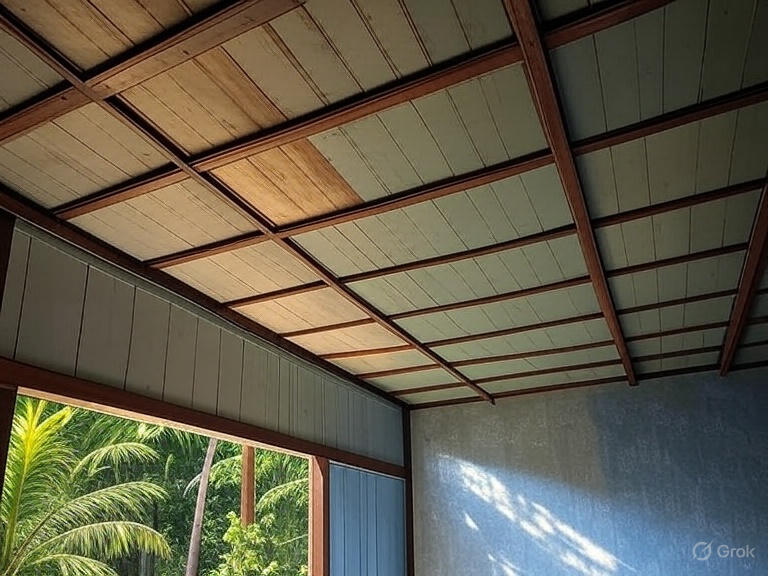
October 01, 2025 - Zed van der Vyver
Introduction to Ceilings in Thailand
Ceilings are an often-overlooked part of building a home in Thailand, but they play a vital role in comfort, safety, and style. In a country with intense heat, heavy rains, and high humidity, the right ceiling can make all the difference. This blog will explain why ceilings are essential in Thailand, the different types for various needs, how they’re made, and what they might cost. No construction knowledge required—just clear info to help you understand this key element of your home!
Why Ceilings Are Essential in Thailand
Ceilings do more than cover the top of a room—they protect you from the elements and enhance your living space. In Thailand, where temperatures can soar above 35°C in places like Bangkok and monsoon rains pound roofs, ceilings insulate against heat and keep water out. They also hide wiring and pipes, improve acoustics in noisy areas like Chiang Mai’s busy streets, and add aesthetic appeal, from traditional Thai designs to modern flat finishes. Whether you’re in a flood-prone area like Ayutthaya or a coastal spot like Phuket, a good ceiling ensures comfort and durability.
Types of Ceilings for Different Scenarios in Thailand
Ceilings come in various forms, and the best choice depends on your climate, budget, and design preferences. Here’s a look at common types in Thailand and where they fit best:
Gypsum Board Ceilings
Use: Modern homes or offices.
Why: Made from plasterboard, they’re lightweight, easy to install, and allow for lighting or air vents. They’re common in urban builds.
Example Scenario: A condo in Sukhumvit.
Wooden Ceilings
Use: Traditional or luxury homes.
Why: Crafted from teak or other hardwoods, they add warmth and cultural charm. Treated wood resists Thailand’s humidity.
Example Scenario: A villa in Chiang Rai.
Concrete Ceilings
Use: High-rise buildings or flood zones.
Why: Solid and waterproof, they’re durable against heavy rain and provide structural support. Often exposed or plastered.
Example Scenario: An apartment in Nonthaburi.
Metal False Ceilings
Use: Commercial spaces or humid areas.
Why: Made from aluminum or steel panels, they resist rust and are easy to clean. They also reflect heat.
Example Scenario: A shop in Phuket.
Your choice depends on your home’s purpose, the local weather, and your aesthetic goals. Thai brands like SCG or local artisans offer tailored solutions.
How Ceilings Are Made in Thailand
Ceilings in Thailand are built to handle the tropical climate while meeting functional and decorative needs. Here’s a general overview of the process:
- Planning: The ceiling height and design are planned based on room use and local conditions, like flood risk in low-lying areas.
- Framework: A metal or wooden frame is erected, attached to walls or beams. For concrete, formwork is set up to hold wet concrete.
- Material Application: Gypsum boards are screwed onto the frame, often with insulation added for heat. Wooden panels are nailed or glued. Concrete is poured and cured, while metal panels are clipped into place.
- Finishing: Joints in gypsum are taped and plastered, then painted. Wood is varnished or stained. Concrete might be left raw or covered with plaster, and metal panels are coated for corrosion resistance.
- Installation: Lighting fixtures, fans, or vents are added, with waterproofing applied in rainy zones like Chiang Mai.
Local workshops in rural areas might craft wooden ceilings by hand, while factories in Bangkok produce gypsum and metal ceilings for urban projects.
Cost Comparison of Ceilings in Thailand
Ceiling costs in Thailand vary by material, size, and installation complexity. Here’s a breakdown (in Thai Baht per square meter, as of October 2025):
| Ceiling Type | Cost (THB per sqm) | Typical Use | Notes |
|---|---|---|---|
| Gypsum Board | 300–800 | Modern homes | Low cost; adds for lighting or insulation. |
| Wooden | 1,500–4,000 | Traditional homes | Teak drives price; maintenance adds cost. |
| Concrete | 500–1,500 | High-rise builds | Includes formwork; labor-intensive. |
| Metal False | 400–1,200 | Commercial spaces | Panels are cheaper; coating adds cost. |
Example Calculation: A 20 sqm gypsum ceiling might cost 6,000–16,000 THB, while a wooden ceiling of the same size could be 30,000–80,000 THB. Installation adds 200–600 THB per sqm, higher in cities like Pattaya. Prices are up 10–20% since 2020 due to material supply challenges.
Final Thoughts
Ceilings in Thailand are a practical and stylish way to protect your home from heat and rain while enhancing its interior. Whether you’re installing a gypsum ceiling in a modern condo or a teak one in a traditional house, there’s a type for every need. Consider your climate, design preferences, and budget, and consult local suppliers for the best fit. Ceilings might be out of sight, but they’re a foundation of comfort. Got questions? Leave a comment—we’re here to help!
Tags: Ceilings in Thailand, Home Design, Ceiling Types, Cost Guide
